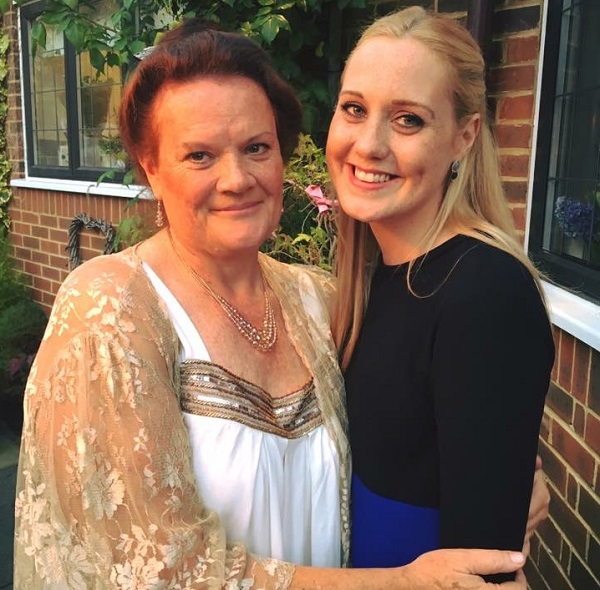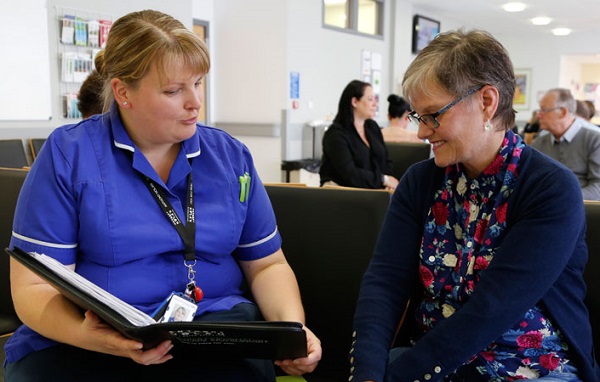Megan was diagnosed with aplastic anaemia when she was 11 years old, and had a double cord transplant at 17. After this failed, she received a haploidentical or 'haplo' transplant from her mum. (This is a transplant based on a 50% match, usually from a parent).
Megan is now 25, and in her fifth year of medical school, studying oncology. She spoke to Billie in the Patient Services Team about her experiences.
My diagnosis
All through junior school, I was an active swimmer, going three or four times a week. But when I started secondary school I was finding that level of exercise hard. My family and I thought it was a bit odd, but just put it down to the stress of starting a new school.
When I found I was getting out of breath on a short walk from the station to my school, I knew something was wrong. It was uphill, but not a big hill! I was having to stop and rest, and I’d also noticed some little bruises.
My mum’s friend thought I looked jaundiced, but my mum said, ‘No, she’s fine, she’s just losing her tan’. My mum is a nurse, by the way!
But we went to my GP, and he did some tests. I remember being in a Religious Studies lesson, and being told to pack up my things as my mum was here to pick me up. I was like, ‘What? What’s happened?’
She took me straight to the hospital, where we discovered my counts were all very low. It all started from there.
I was then diagnosed with aplastic anaemia, and had three courses of ATG (antibodies) over a number of years. Despite this treatment, after two years I relapsed again and they told me I needed a stem cell transplant in order to survive.
My cord transplant
I have one sibling; but she wasn’t a match, so they searched the donor registries. And sadly there wasn’t a match there, either.
In all honesty, when they first started looking for a donor, I was only 15; I didn’t really understand what this meant for me, and I don’t remember any sense of urgency at that point.
When I started to relapse, I remember them saying, ‘You don’t have a tissue match, but we are still looking.’ So cord blood was their next port of call.
I had two matches, one from England and one from America. Again I didn’t really understand, especially when they said they were using two. I was like, ‘How does that work?’
My consultant at King’s was brilliant. I think we were very lucky, and we trusted that she knew what was best. I never second-guessed her or wondered if I was on the right course. She was very nice and calm and obviously knew what she’s talking about!
Unfortunately, they knew quite soon afterwards that the cord transplants hadn’t worked. While I was still in hospital, they were discussing a second transplant there and then as my counts were so low. But they did start to rise, and after about six weeks I was allowed to go home for a bit.
I knew I’d need another transplant, but I was desperate to get out of hospital! I was going stir crazy in there. The isolation period was really hard.
I remember watching lots of TV to pass the time; now I find I don’t really like just watching TV! Being within the same four walls every day gets to you. I only left once a week to have an X-ray. Towards the end of my stay, my mum was putting pressure on the medical team to let me out even just onto the ward for a bit of relief.
I saw a psychologist, and it was her recommendation that I should go home if possible. I’m not sure how helpful I found it at the time, speaking to someone about my emotions. I was very defensive about it all. ‘Oh, I don’t need to see anyone.’
But in hindsight, I was grateful she helped me to get home.
My haplo transplant
King’s decided that a haplo transplant from my mum was a better option than another cord transplant, which worried me. The hospital had only performed a haplo transplant on one other person with my disease - it had been successful, but there was a lot of uncertainty.
I understood much more by that time, and knowing it was only a 50% match made me scared, especially as I knew I’d need to have much harsher chemotherapy. I hadn’t lost my hair with the first transplant, but with the haplo transplant, I knew I would.

How my mum helped
I coped better with losing my hair as a teenager than I thought I would. I remember it being very upsetting for my mum. She still has a little bag of my hair, which is a bit creepy! (Laughter)
What upset me more was how long it took to grow back; that seemed like forever. I had started back at college then, and I felt strong enough to go out with my friends, but I had to wear a wig which wasn’t the nicest thing.
I’m really close to my mum, as a result of everything I’ve been through. It all started when I was a kid, and in paediatrics you have a parent stay with you in hospital. My mum stayed by me, always.
My recovery, and my fertility
Going home after my second transplant, I was surprisingly well. My counts came up and I didn’t have to go for as many transfusions. I was advised to take it easy but I wanted to get on with my life! My haplo transplant was in April, and I started college that September. I got away lightly with a small amount of GVHD and fatigue that are all fine now. I realise I was very lucky.
The element that still stays with me, and is upsetting, is that I didn’t have any fertility preservation options before my first transplant, and I had to push for it before my second one. But by that time I’d already had radiation. My counts were very low, and I wasn’t able to have egg retrieval. It was time-sensitive, probably a lot more than I realised at the time.
It’s something that I think about a lot. I’m a medical student, and I did a study on the effects of fertility on leukaemia patients who’ve had allogenic and autologous transplants. So naturally that stirred it all up, and then I did a obstetrics placement, which got me upset.
The problem is not knowing for certain either way. The doctors would say that I’ve gone through menopause, but I also have a bit of ovarian tissue stored. One person has had a baby through that now successfully, so it’s not impossible, but far from routine. I guess the uncertainty means I can’t completely write it off in my mind.
To be honest, it upsets me the most out of all my experiences. I have a boyfriend now and he knows and knew before we got together as we were friends, so that’s a massive help. He’s medical too, so he really understands the situation.
I remember my mum asking if he knew, when we first got together. I think it’s something she worries about for me and my future.
My future
I’ve finished my fourth year at medical school now. At first I wanted to be a haematologist as I knew lots about it! But it’s a bit close to home. So this year, I am doing a Master’s in oncology. It’s still close to home, but solid tumours seem that bit extra removed from my own experiences.
I’m really proud of my achievements so far, but I’ve always been quite focused, despite having some doubts that I might not get well again.
There was a time where I got an infection in hospital, and I was so sick I wondered if I’d ever even make it home.
How you can make a difference
To anyone wondering about signing up to the donor register, I would say that it's not as scary as they might think, and it's so important to the person on the receiving end.
In my eyes, there is nothing better you could do for someone. It's so important for people that currently don't have a match, or who aren’t lucky enough to have a parent, sibling or relative who can help.
Without a transplant, there really is no quality of life for people who are in need of one and it's an incredibly scary time. If you could help alleviate that directly, I think anyone would agree - that's amazing!
Q&A
One of our Clinical Nurse Specialists, Susan Paskar at the Freeman Hospital, Newcastle, spoke to us about her experience of Haplo Transplants:

I have been told my Sibling is not a full match, and there is not a well matched donor available through the international donor registries, so what happens next?
If a suitable donor has not been identified, your medical team may consider a transplant using an alternative donor source. This might be a matched Umbilical Cord Transplant, or a Haploidentical or ‘Haplo’ transplant.
What is a ‘Haplo’ transplant?
A Haploidentical or ‘Haplo’ transplant is a half matched bone marrow or stem cell transplant, and in some cases is a suitable alternative to a traditional fully matched transplant.
This type of transplant is less common, and will be carefully managed by your medical team to minimize the risks of transplant rejection, and organ damage from graft versus host disease (GvHD)
Who might be eligible to be a Haploidentical donor?
Potential donors must be a first degree relative of the patient, such as biological parents, siblings, children (usually aged 16 or older) or half siblings, and still meet the selection criteria, such as fitness level and willingness to donate cells.
How does a haplo transplant work in practice?
The patient experience of receiving a haplo transplant is essentially very similar to a traditional transplant. Before getting the donor cells, you will be admitted to hospital, and receive conditioning chemotherapy and some radiotherapy to prepare your body for receiving the transplant. You will also receive further medication to reduce the chance of the transplant being rejected, and medication which will continue after discharge to reduce the risks of graft versus host disease (GvHD). During your time in hospital your blood counts will be low, and will be managed in the same way as a standard transplant. The recovery time for neutrophils is similar to a standard transplant, but platelet recovery, may take a few more days than a standard transplant. The infection risks associated with transplant will be the same.
Your transplant centre will monitor your blood counts and bone marrow function carefully to assess how well the transplant is working, and you will be continue to have after care in the BMT out-patient clinic in the same way as a standard transplant.
What are the risks and benefits of having a haplo transplant?
Existing research suggests the overall survival rates for haplo transplant recipients is better than patients who receive a mismatched transplant, which is encouraging, but this is still a relatively new technique which is being closely evaluated, and the long term risks and benefits are still to be fully appreciated.
For more information on how transplant may affect your fertility, see our Fertility after a stem cell transplant page.
For more info about having a haplo transplant, see our What is a haploidentical stem cell transplant? page.
